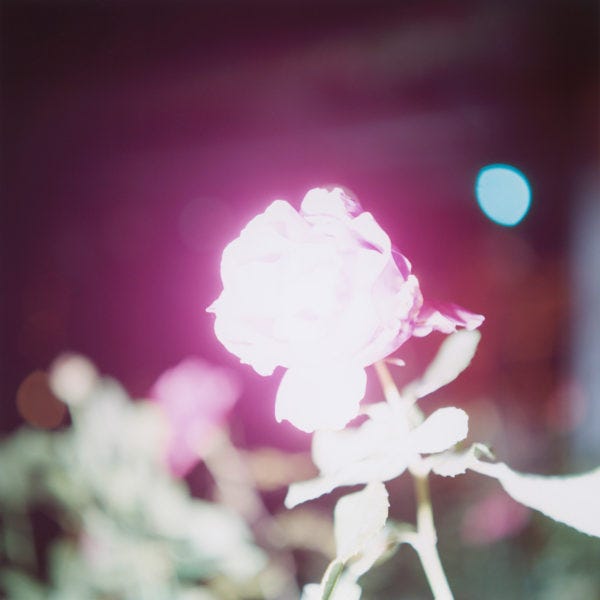
Hi fam,
I've been reading extensively about intimacy. The more I crave it, the more I want to learn about it. Our disconnect from what's happening around us—the world, the ecosystems, our own bodies—has drawn me towards this topic, from embodied activism to deep ecology to sexual intimacy.
Let’s take a look at art, photography, poetry and of course, ecology, through the lens of intimacy. Let’s go.
At its core, intimacy is a highly energetic practice where we remove the distance between one and the other—be it a plant, another human, or a space. The practice of intimacy is in itself the practice of creating, acknowledging and embodying sameness. While acknowledging our uniqueness, intimacy is the act of removing the space between us—spiritually, mentally, physically, bodily.
"Intimacy is a highly energetic practice where we remove the distance between one and the other—be it a plant, another human, or a space."
And I am by no means negating the multiplicity of our identities. However, it is often our focus on what makes us different, on the divide between us and what’s out there, that stays in the way of intimacy.
John Wineland speaks of Sacred Intimacy, which he divides into three layers:
Embodied and energetic practice (Somatic)
Human to human, as in sharing our humanity
and the divine in us recognizing the divine in the other.
So, it’s starts with the body.
The embodied energetic practice required to achieve this first layer of intimacy begins with recognizing that there's a hum of life everywhere. Everything has a frequency—a pet, a tree, a stream of water, a child. And we have the capacity to train our bodies to feel that.
My dog senses exactly when I'm upset or happy; she can tell when a storm is approaching or when somebody on the street is getting too close to me. She's deeply attuned to my energetic field and the hum of life that passes through us.
The hum of life that passes through us.
Life is passing through us.
So, this first somatic door to intimacy gets open once we begin to be attuned to the frequencies of life moving through us.
Life is living us, so to speak. Life is propelling us into existence. To stop and embody this is to get intimate with the energy moving through our system—emotions and sensations flowing through our body. A beautiful meditation in itself.
Once that's established, we can create a connection with another being: human to human or human to non-human.
"The hum of life that passes through us. Life is passing through us."
Robin Wall Kimmerer explores intimate relationships with plants through indigenous wisdom and scientific knowledge. She invites us to learn the language of animacy, which I would say it’s the language of intimacy.
In her book she beautifully says:
I come here to listen, to nestle in the curve of the roots in a soft hollow pine of needles, to lean my bones against the column of white pine, to turn the voice in my head until I can hear the voices outside it: the shhhh of wind in needles, water trickling over rock, nuthatch tapping, chipmunks digging, benefit falling, mosquito in my ear, and something more—something that is not for me, for which we have no language, the world-less being of others in which we are never alone.
Listening in wild places, we are audience to conversation in a language not our own.
Human to human & non-human Intimacy
If Wineland calls the second phase the human to human phase, I would call mine, the human to the human and to non-human. Like Wall Kimmerer says, once we tune into the wild places, we are in a word-less space in which we are never alone. This goes indeed beyond words. This is truly the work of depth and of listening. The practice of opening up.
I could hear the light beings as they entered every cell. Every cell is a house of the god of light, they said. I could hear the spirits who love us stomp dancing. They were dancing as if they were here, and then another level of here, and then another, until the whole earth and sky was dancing.
We are here dancing, they said. There was no there.
There was no "I" or "you."
There was us; there was "we."
There we were as if we were the music.
You cannot legislate music to lockstep nor can you legislate the spirit of the music to stop at political boundaries—
—Or poetry, or art, or anything that is of value or matters in this world, and the next worlds.
This is about getting to know each other.
We will wind up back at the blues standing on the edge of the flatted fifth about to jump into a fierce understanding together.— Joy Harjo - "Conflict Resolution for Holy Beings"
Deep Ecology and the Steps to Establishing Divine Intimacy
If we continue with the steps introduced by Wineland, we’ve got divine intimacy as last. And here’s where things get juicy. They get trascendental. Once we’ve established the somatic work, the act of deep-listening of a conversation in a language not our own, we are stepping into the divine and utterly sacred space. Once we have the facts cleared, the space clean and the mind and heart open, we get to experience intimacy in its ultimate state: Love.
“Love is not a feeling, but the characteristic of a productive relationship.” says Andreas Weber, in Matter and Desire: An Erotic Ecology
The study of deep (and in the words of Weber, Erotic) ecology teaches us about the oneness I mentioned earlier. The supposed division between us and nature is actually an economy of domination and extraction. So once we let go of the idea that we are somehow separated from what’s out there, once we call in that divine, juicy, erotic ecology—the cosmic frequencies that keep us all transcending—we get to experience intimacy in its most sacred, exquisite form.
Without getting too "woo-woo," it's connection at the deepest, most profound level. I truly believe that it is what we are here meant to experience.
Life, the very existence of it all, is calling for our attunement, for our intimacy. So if the erotic, the cosmos, the higher frequencies are calling us back in, it might be a gorgeous invitation to tap into life itself, into another human or non-human being and ultimately, into ourselves.
Until next time.
Thank you for reading, following and sending me your lovely feedback. Also, for a coffee a month you get weekly: deep-ecology practices, mood-boards around inspiration, creativity and deep listening and one epic album or mixtape, from spiritual jazz, to forest bathing, to emotional techno. Support this publication by becoming a paid subscriber.
Also!!! I’m craving sharing my love for the arts, deep ecology and MUSIC through mixtapes and or a podcast. Here my question to you:
Intimate deep ecology practice, mood-boards and a playlist in ode to Stevie Wonder’s intimate relationship with plants
For all my fellow rooted subscribers, thank you for being here, first of all. Here my beloved intimate deep ecology practice:
Keep reading with a 7-day free trial
Subscribe to Postcards from Somewhere to keep reading this post and get 7 days of free access to the full post archives.


